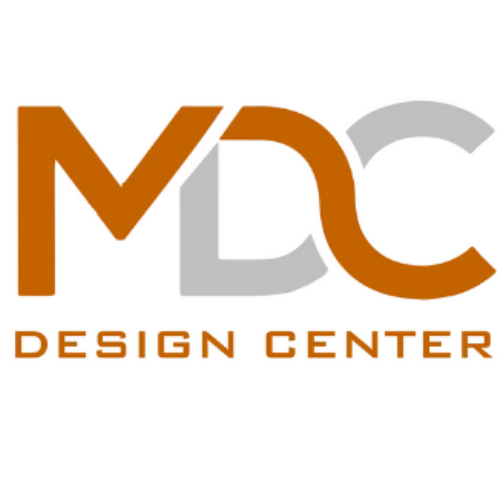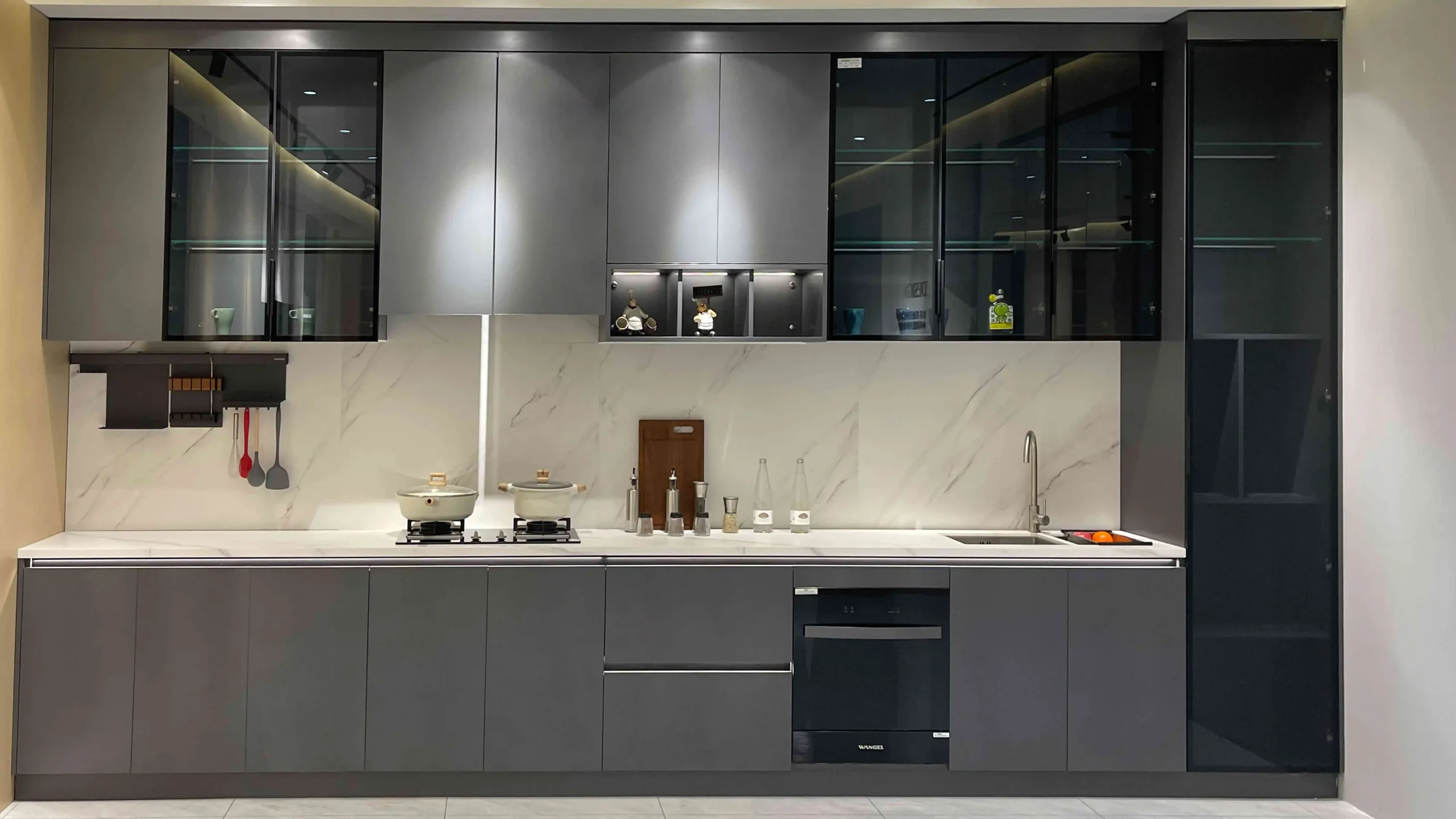When it comes to kitchen design in 2025, mixing metal finishes is more than just a fleeting trend—it’s a creative expression of balance, contrast, and elegance. Whether you’re revamping a classic white kitchen or designing a modern culinary space from scratch, combining warm and cool toned metals can add depth, sophistication, and personality to your space.
At MDC Design Center, we believe that your kitchen should reflect your unique taste. So let’s explore how mixing metals in the kitchen can help you create a high-end yet timeless look.
Why Mixing Metals Works in Modern Kitchens
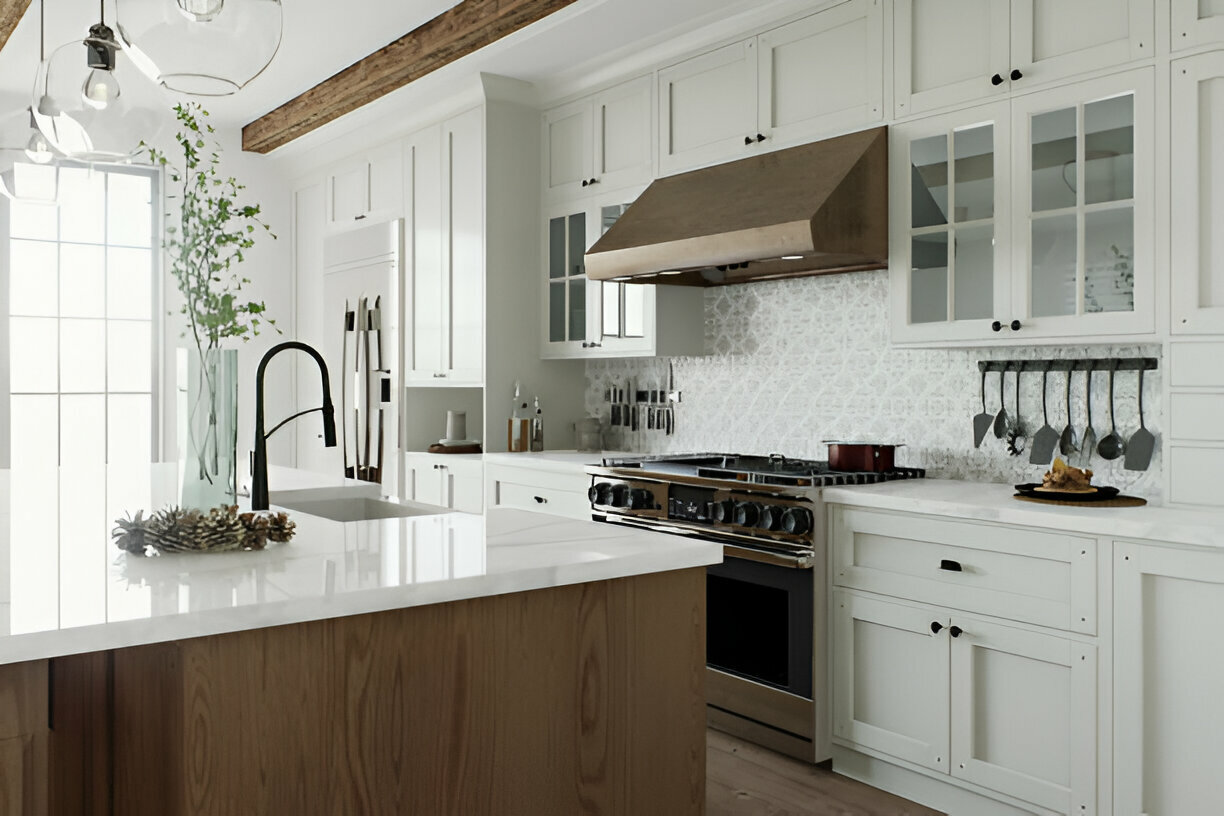 In the world of contemporary interior design, rules are being rewritten—and nowhere is this more evident than in the kitchen. Gone are the days when every fixture and finish had to match precisely. Today’s most compelling kitchens are layered, textural, and full of contrast. At the heart of this evolution is the art of mixing metals in the kitchen—a style strategy embraced by top interior designers and savvy homeowners alike.
In the world of contemporary interior design, rules are being rewritten—and nowhere is this more evident than in the kitchen. Gone are the days when every fixture and finish had to match precisely. Today’s most compelling kitchens are layered, textural, and full of contrast. At the heart of this evolution is the art of mixing metals in the kitchen—a style strategy embraced by top interior designers and savvy homeowners alike.
The Evolution of Kitchen Finishes
Traditionally, designers leaned on a single metal finish—stainless steel, brushed nickel, or oil-rubbed bronze, for instance—to create visual consistency. This approach worked well in conventional kitchens, where symmetry and sameness were prized. But modern design celebrates individuality and contrast. Mixing metal finishes invites personality into the space, infusing kitchens with dimension, sophistication, and a designer-curated feel.
Visual Interest Through Contrast and Balance
Layering warm and cool metals can energize a room and bring architectural balance to your design. Instead of blending into the background, fixtures like faucets, cabinet hardware, and pendant lights become focal points. Mixed metals help anchor different zones within your kitchen—distinguishing your island from your perimeter cabinets, or your lighting fixtures from your plumbing.
This technique doesn’t just look intentional—it is intentional. By thoughtfully combining metals, you create a space that feels rich, curated, and inviting without appearing chaotic or overly styled.
Rule #1: Choose a Dominant Metal
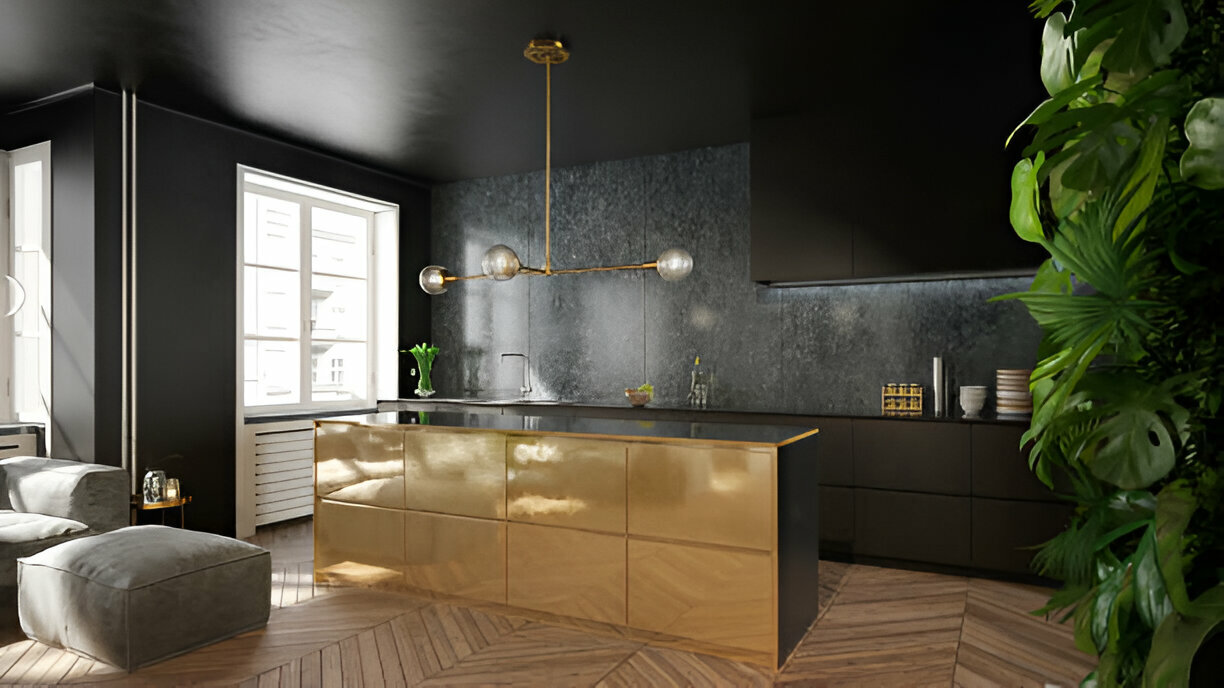 Start your metal mixing journey by selecting a primary metal finish. This will serve as the anchor in your design, appearing most frequently and setting the tone for the space.
Start your metal mixing journey by selecting a primary metal finish. This will serve as the anchor in your design, appearing most frequently and setting the tone for the space.
This dominant metal should cover roughly 60-70% of the hardware and fixtures, such as cabinet handles, faucets, and lighting bases. Consider your kitchen’s style and cabinetry when deciding.
· Brushed Nickel – Subtle, sophisticated, and highly versatile. Excellent for transitional kitchens with cool undertones.
· Stainless Steel – Clean and modern, it pairs well with contemporary appliances and sleek cabinetry.
· Matte Black – Bold and grounding, matte black works across various styles and adds a contemporary edge.
Let’s say your kitchen features white shaker cabinets and quartz countertops. You might opt for polished nickel as your dominant finish—seen in your faucet, light fixture bases, and sink accessories. From there, introduce complementary metals to build dimension and depth.
For inspiration, view the kitchen remodeling projects we’ve completed at MDC Design Center, where dominant metals guide and elevate each design narrative.
Rule #2: Layer with Secondary Metals for Depth
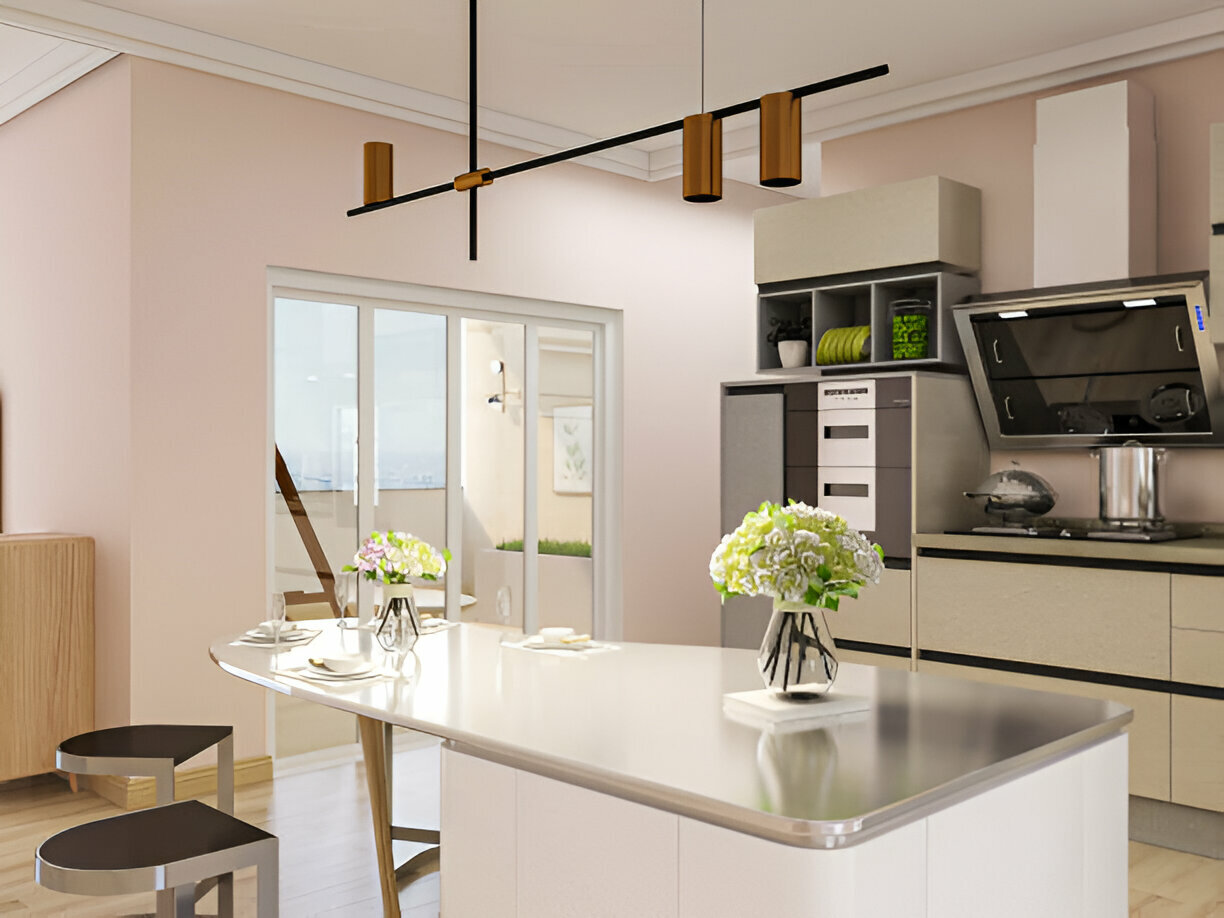 After establishing your dominant metal, it’s time to add one or two supporting metals. These bring variation, richness, and visual hierarchy to the space.
After establishing your dominant metal, it’s time to add one or two supporting metals. These bring variation, richness, and visual hierarchy to the space.
Think of secondary metals as accents in your wardrobe—they should enhance, not overpower. Ideally, secondary finishes should be used in 20-30% of the total metal finishes in your kitchen.
How to Layer Effectively
· Introduce your second metal through cabinet hardware—like knobs, pulls, and hinges.
· Use a third finish as an accent on statement fixtures, like a brass wall-mounted pot filler, a copper pendant light, or a black range hood.
· Repeat each finish at least twice in different areas of the room to establish rhythm and balance.
For example, envision a kitchen where chrome is dominant, with brass cabinet pulls as the secondary finish and matte black pendant lights serving as a striking third accent. This approach brings elegance and warmth to a white kitchen while avoiding visual clutter.
Want to see real-life examples? Browse our luxury kitchen projects where layered metals create inviting, multi-dimensional spaces.
Rule #3: Consider Finish and Sheen—Not Just Color
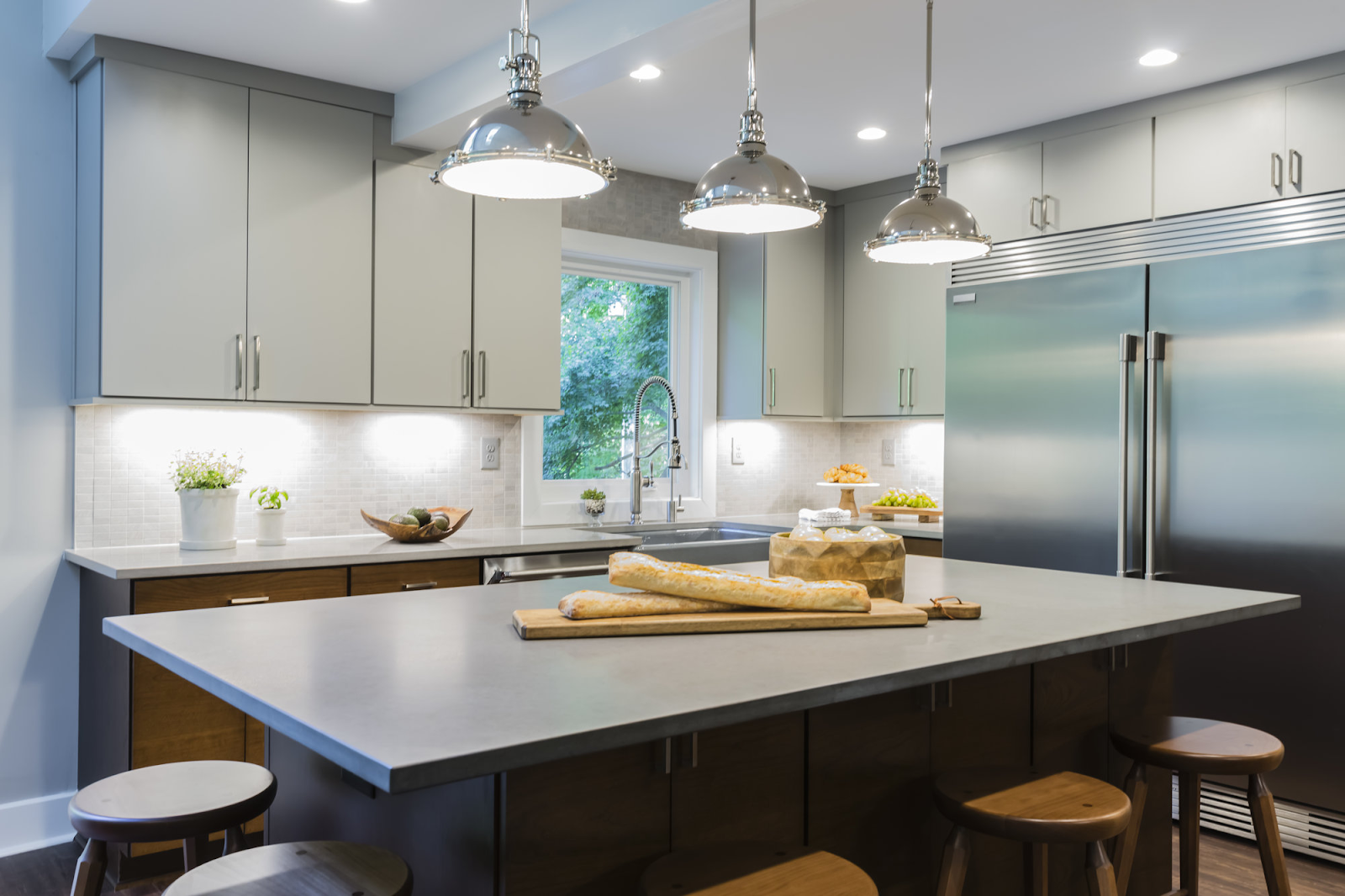
Hyundai L&C USA
When combining metals, it’s not just about what finish you choose, but how it reflects light and feels to the touch.
Even two types of brass can look drastically different depending on their sheen.
· Polished finishes reflect more light, contributing to a glam, high-end look. Best used in modern or Hollywood Regency-inspired kitchens.
· Brushed finishes offer a soft, matte appearance. Ideal for transitional or coastal styles where subtlety is key.
· Aged or antique finishes bring warmth and character to vintage or traditional kitchens.
· Hammered or textured metals work well as statement pieces, particularly in farmhouse or Mediterranean-style kitchens.
We recommend mixing sheens just as thoughtfully as you would color—using brushed nickel cabinet hardware with a polished chrome faucet, for example, creates a subtle interplay that feels curated rather than clashing.
Learn how to match these sheens with your kitchen cabinets or custom countertops to create balance and flow.
Rule #4: Follow the Visual Zones Method
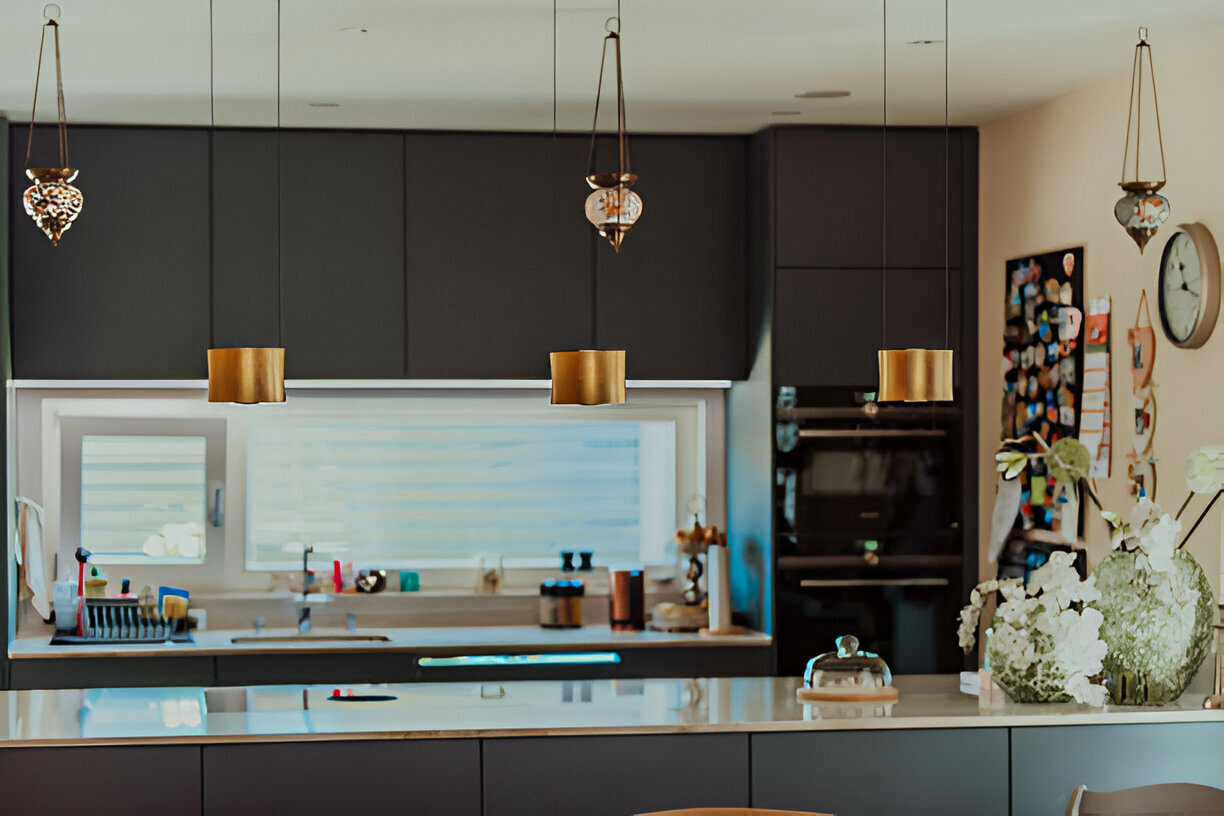 One of the most effective—and underrated—design strategies for mixing metals in the kitchen is to organize your space into functional zones. Each zone can feature a different metal finish, giving the kitchen an intentional, balanced feel without overwhelming the eye.
One of the most effective—and underrated—design strategies for mixing metals in the kitchen is to organize your space into functional zones. Each zone can feature a different metal finish, giving the kitchen an intentional, balanced feel without overwhelming the eye.
How It Works:
· Lighting Zone – Feature brass or aged gold finishes on pendant lights above the island. Their warmth draws attention and creates a welcoming ambiance.
· Plumbing Zone – Stick with polished chrome or brushed nickel for faucets, pot fillers, and other plumbing fixtures. These are durable and timeless.
· Cabinet Hardware Zone – Use matte black or bronze for drawer pulls and knobs to ground the space and complement the cabinetry.
This method is not just visually effective—it also brings a sense of order to your design process. By assigning a metal to each functional category, you maintain cohesion within each zone while still incorporating a variety of finishes across the entire room.
Want to see how our team applies this method in real remodels? Visit our modern kitchen remodeling portfolio and explore projects that showcase beautifully balanced finishes.
Rule #5: Let Other Kitchen Elements Lead the Way
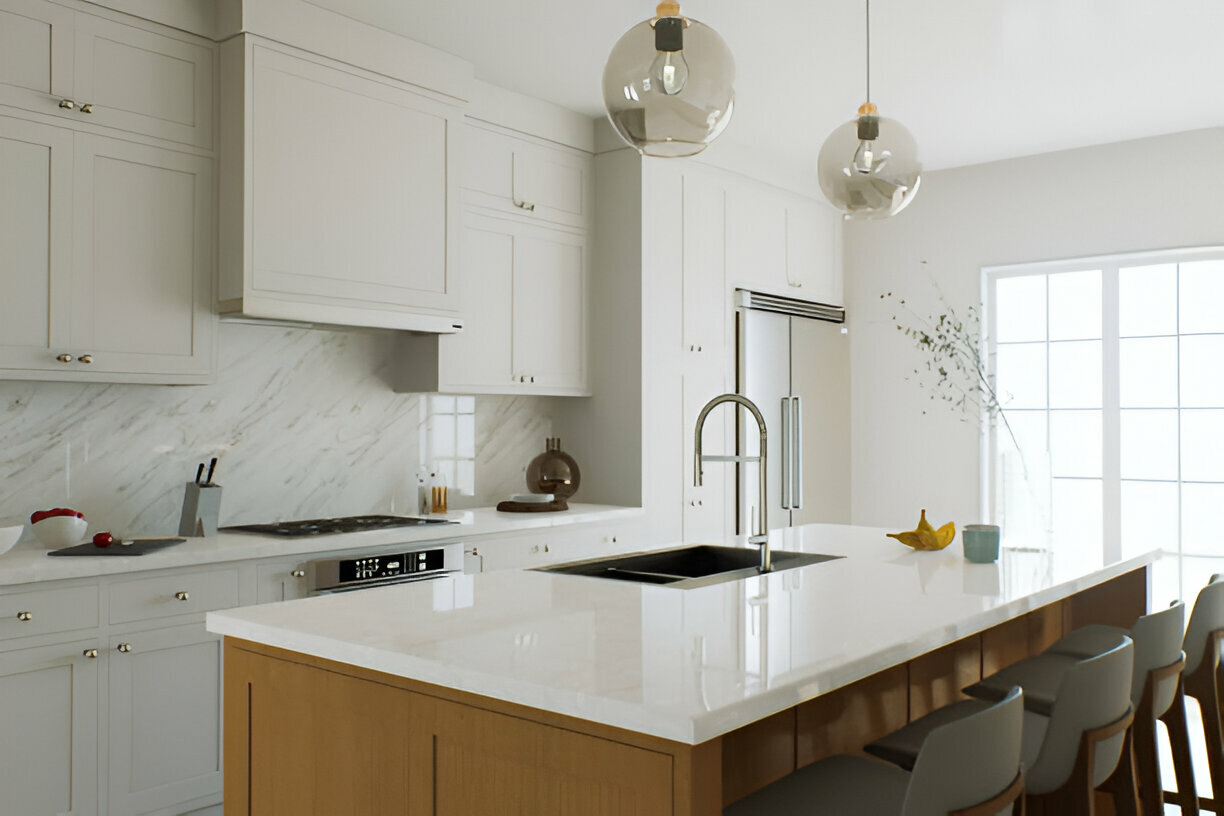 Metals shouldn’t be selected in isolation. A well-executed design considers the existing color palette, materials, and architectural elements of the kitchen. This ensures your metal finishes don’t feel like an afterthought—but rather, a natural extension of your overall aesthetic.
Metals shouldn’t be selected in isolation. A well-executed design considers the existing color palette, materials, and architectural elements of the kitchen. This ensures your metal finishes don’t feel like an afterthought—but rather, a natural extension of your overall aesthetic.
Design Harmony Through Existing Features:
· Cabinet Colors
· White Cabinets pair effortlessly with almost any finish—try brushed brass, black, or chrome.
· Natural Wood Tones benefit from the richness of warm metals like copper or oil-rubbed bronze.
· Countertops
· A white quartz or marble countertop pairs best with polished metals like chrome or nickel for a clean, modern feel.
· Granite surfaces with natural flecks offer flexibility for aged brass or black finishes.
· Backsplashes
· Subway tile or neutral stone tiles provide a subtle backdrop that allows your mixed metals to stand out without competition.
· A marble backsplash works well with both warm and cool tones, making it a flexible canvas for mixed finishes.
See how we integrate these elements seamlessly in our kitchen countertop gallery and cabinet collections.
Rule #6: Apply Metal Mixing Beyond Just Hardware
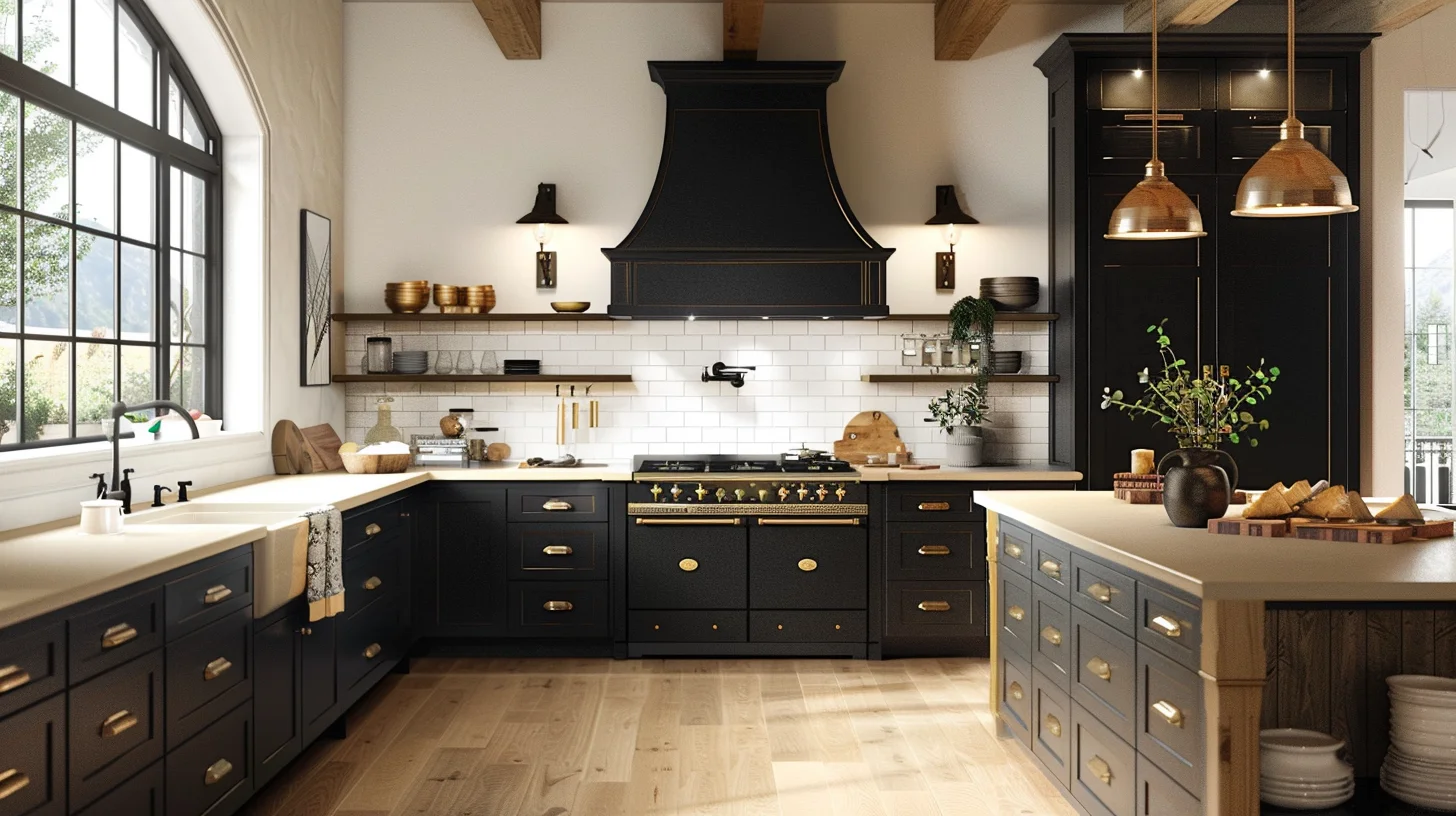 While many homeowners stop at the knobs and faucets, a truly cohesive mixed metal kitchen brings this design philosophy to every detail in the space—from lighting fixtures to bar stools and open shelving.
While many homeowners stop at the knobs and faucets, a truly cohesive mixed metal kitchen brings this design philosophy to every detail in the space—from lighting fixtures to bar stools and open shelving.
Mixed Metal Applications to Consider:
· Kitchen Faucets – Consider a two-tone faucet, such as brushed nickel paired with a matte black handle or spout.
· Cabinet Hardware – Try matte black cabinet bases paired with brass mounting screws or mixed metal drawer pulls.
· Shelving Supports – Combine brushed stainless steel brackets with copper or bronze shelves to create depth and industrial charm.
· Lighting – Hang aged brass pendants above the island and pair them with a polished nickel chandelier in the dining nook for cohesive contrast.
· Seating & Furniture – Use bar stools with black legs and brass foot rails, or chairs with nickel accents and wood seats.
Even in a small kitchen, mixing metals works beautifully—just opt for subtle pairings, like brass cabinet pulls with a black faucet, to avoid visual overload.
Rule #7: Limit to Two or Three Metal Finishes
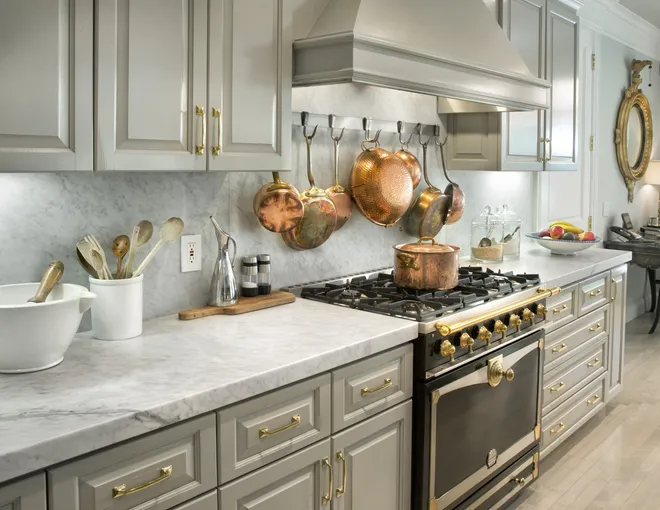 While mixing metal finishes brings energy and contrast to your kitchen, moderation is essential. Interior designers almost unanimously agree: keep your metal selection to no more than three different finishes.
While mixing metal finishes brings energy and contrast to your kitchen, moderation is essential. Interior designers almost unanimously agree: keep your metal selection to no more than three different finishes.
Any more than that, and the space can begin to feel chaotic, uncoordinated, and visually noisy.
How to Maintain Balance:
· Choose one dominant metal, one supporting metal, and (optionally) one accent finish.
· Ensure each metal is repeated at least twice in the design to establish rhythm.
· Use the same sheen or tone (e.g., all brushed or all polished) if you’re mixing multiple metal colors.
This tip is particularly useful in open concept kitchens, where too many clashing finishes can disrupt the flow between the kitchen, dining, and living areas.
Rule #8: Coordinate with Appliance Finishes Thoughtfully
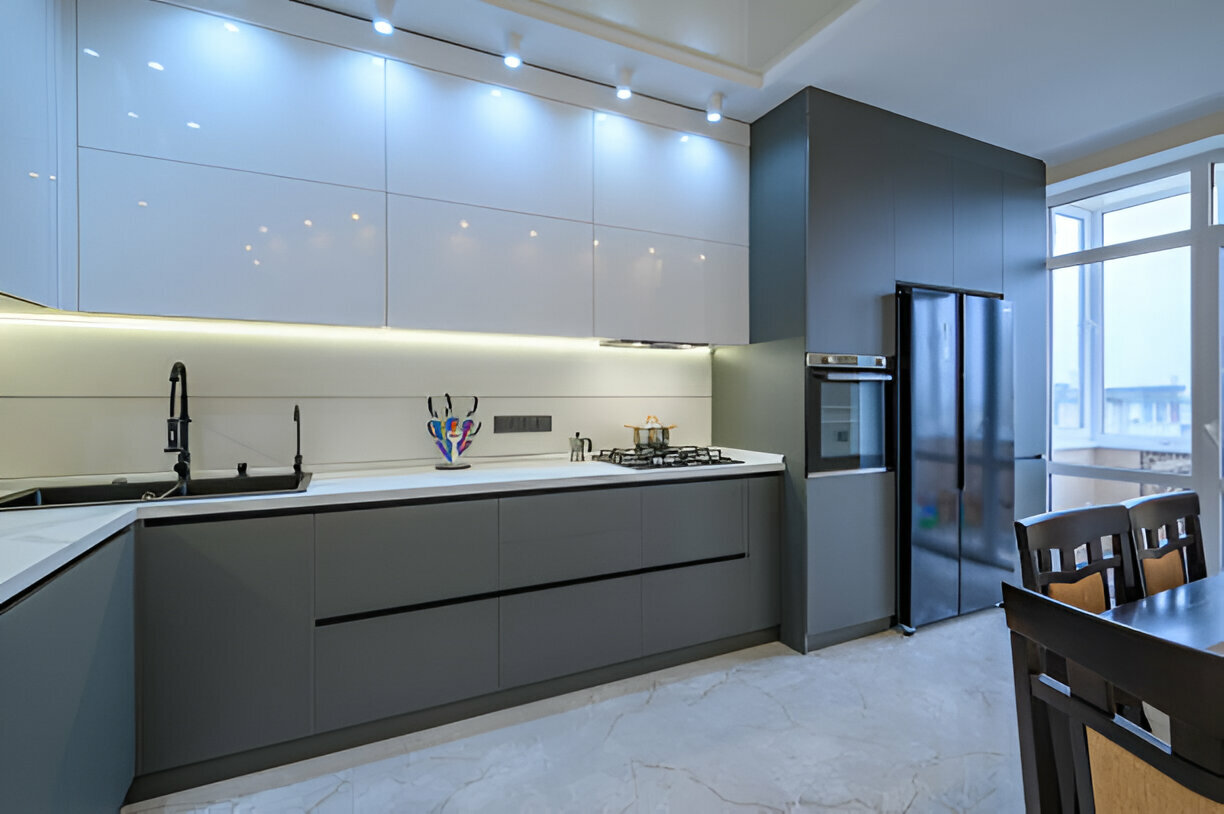 One common pitfall when planning a mixed metal kitchen is defaulting every metal choice to match your appliances. Don’t feel tied down by stainless steel.
One common pitfall when planning a mixed metal kitchen is defaulting every metal choice to match your appliances. Don’t feel tied down by stainless steel.
Appliance Coordination Tips:
· Stainless steel appliances are neutral and pair well with nearly all other metals.
· Matte black appliances are modern and work best when echoed in cabinet pulls or lighting details.
· Paneled appliances (custom fronts) offer the most flexibility, allowing your metal accents to shine without visual interference.
For a tailored look, we recommend integrating your appliance selection into your overall kitchen remodeling plan. Our team ensures all details—from fixtures to finishes—work in perfect harmony.
Mixing Metals in a White Kitchen
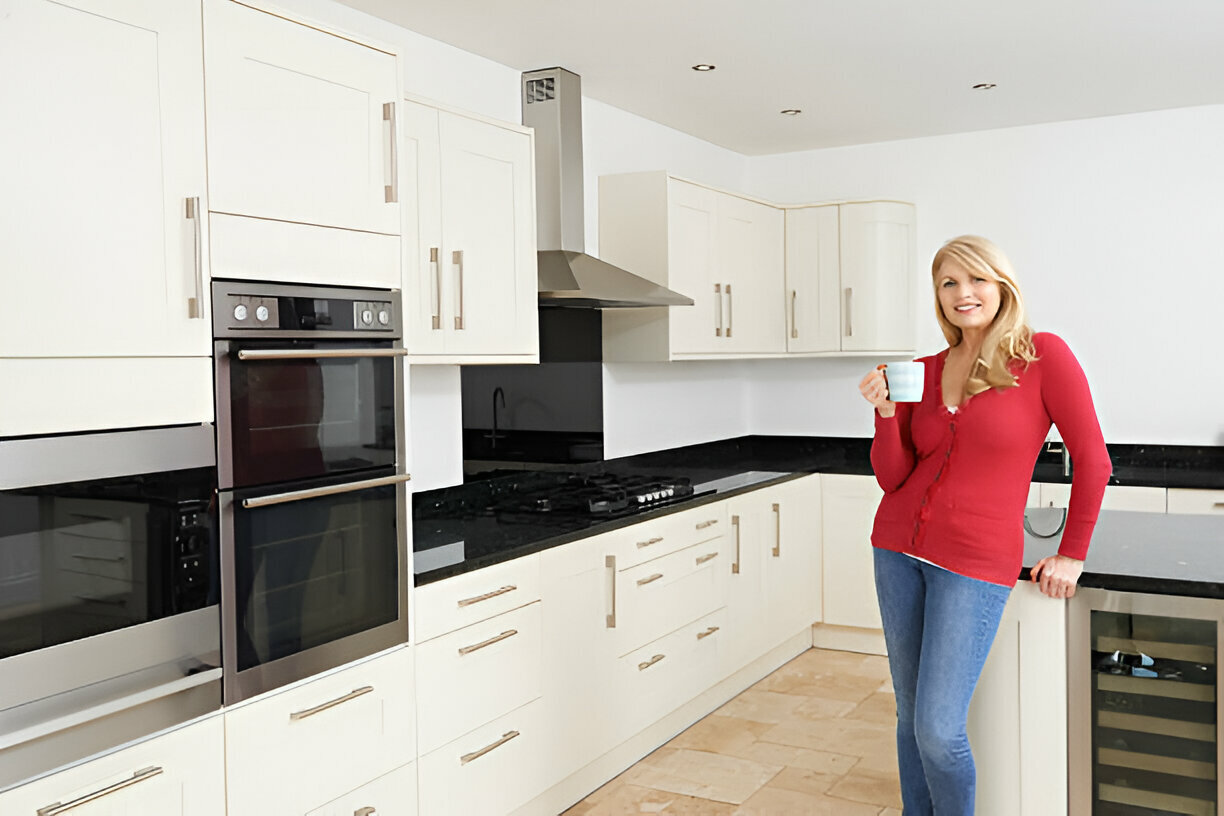 If you’re designing around a white kitchen—be it farmhouse, modern, or transitional—you’ve got the ideal backdrop for mixed metals. White acts like a blank canvas, allowing both warm and cool metal tones to truly stand out.
If you’re designing around a white kitchen—be it farmhouse, modern, or transitional—you’ve got the ideal backdrop for mixed metals. White acts like a blank canvas, allowing both warm and cool metal tones to truly stand out.
Winning Combinations for White Kitchens:
· White shaker cabinets with brushed brass pulls create a warm, inviting space.
· Polished chrome faucets with a black granite sink add bold contrast.
· Gold pendant lights paired with black stools bring glamor to marble countertops.
You can find examples of these timeless pairings in our classic kitchen projects, where mixed metal kitchen ideas come to life with impeccable balance.
Before committing to your metal mix, keep these expert tips in mind:
· Test finishes under multiple lighting conditions, both natural and artificial.
· Buy hardware and fixtures from the same manufacturer when using similar finishes—polished brass from two different brands can look dramatically different.
· Stick to a repeated pattern—repetition is the key to harmony.
· Explore platforms like Houzz, or check out our design portfolio for real-life inspiration and expert craftsmanship.
Let MDC Design Center Be Your Guide
Designing with mixed metals is an art—and when done right, it turns your kitchen into a masterpiece. At MDC Design Center, we specialize in creating personalized, elevated kitchen spaces that blend style, functionality, and expert craftsmanship.
Whether you’re beginning a full-home remodel or upgrading your kitchen cabinet hardware, our team can help you explore the perfect balance of metal finishes in the kitchen.
Contact us today through our design consultation page and discover how we can bring your mixed-metal vision to life.
Source Links
-
Mixed Metal Kitchen Finishes: A Guide to the Effortless Look
https://oakandgrainrefinishing.com/mixed-metal-kitchen-finishes-a-guide-to-the-effortless-look/ -
Mixing Metals in Kitchen: A Stylish Guide
https://jane-athome.com/mixing-metals-in-kitchen/ -
How We’re Mixing Metals in Our Kitchen
https://chrislovesjulia.com/how-were-mixing-metals-in-our-kitchen/ -
Mixing Metals in the Kitchen
https://www.fabuwood.com/blog/mixing-metals-in-the-kitchen/ -
How to Mix Metals: Expert Advice
https://www.bhg.com/decorating/lessons/expert-advice/how-to-mix-metals/ -
Shea McGee on Mixing Metals in Kitchens
https://www.homesandgardens.com/kitchens/shea-mcgee-on-mixing-metals-in-kitchens -
How to Mix Metals in Your Kitchen – Hackett House Studio
https://www.hacketthousestudio.com/post/how-to-mix-metals-in-your-kitchen -
Mixing Metals in Kitchen – Stefana Silber
https://stefanasilber.com/mixing-metals-in-kitchen/ -
Design Trend: Mixed Metals in the Kitchen – Kohler
https://www.kohler.com/en/inspiration/design-trend-mixed-metals-in-the-kitchen -
Mixed Metals Hardware Trend – The Kitchn
https://www.thekitchn.com/mixed-metals-hardware-trend-23723207
